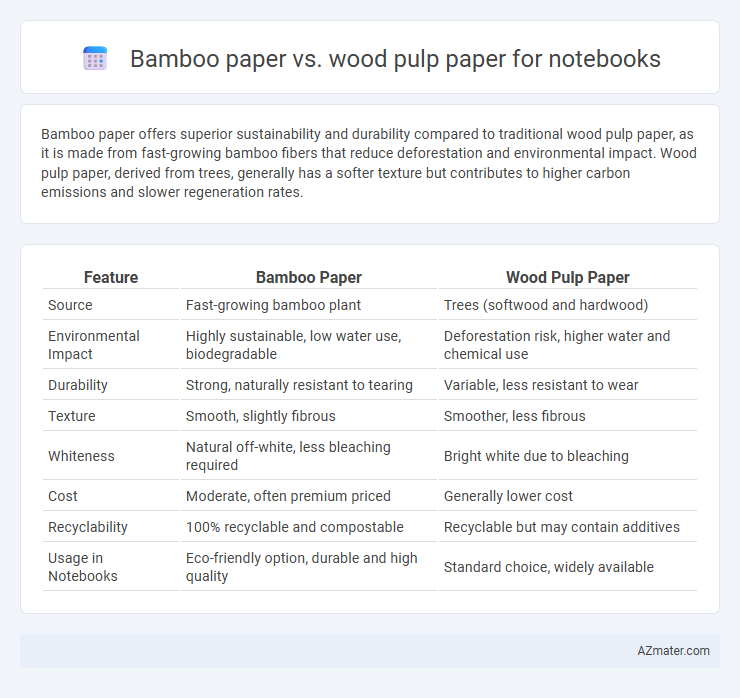Bamboo paper offers superior sustainability and durability compared to traditional wood pulp paper, as it is made from fast-growing bamboo fibers that reduce deforestation and environmental impact. Wood pulp paper, derived from trees, generally has a softer texture but contributes to higher carbon emissions and slower regeneration rates.
Table of Comparison
| Feature | Bamboo Paper | Wood Pulp Paper |
|---|---|---|
| Source | Fast-growing bamboo plant | Trees (softwood and hardwood) |
| Environmental Impact | Highly sustainable, low water use, biodegradable | Deforestation risk, higher water and chemical use |
| Durability | Strong, naturally resistant to tearing | Variable, less resistant to wear |
| Texture | Smooth, slightly fibrous | Smoother, less fibrous |
| Whiteness | Natural off-white, less bleaching required | Bright white due to bleaching |
| Cost | Moderate, often premium priced | Generally lower cost |
| Recyclability | 100% recyclable and compostable | Recyclable but may contain additives |
| Usage in Notebooks | Eco-friendly option, durable and high quality | Standard choice, widely available |
Introduction to Bamboo Paper and Wood Pulp Paper
Bamboo paper is crafted from the fibers of bamboo plants, offering a sustainable alternative to traditional wood pulp paper derived from trees. Bamboo grows rapidly and requires fewer chemicals in processing, resulting in a more eco-friendly production with lower environmental impact. Wood pulp paper, while widely used, involves deforestation and higher energy consumption, making bamboo paper a preferred choice for environmentally conscious notebook manufacturing.
Raw Materials and Sustainability
Bamboo paper for notebooks is made from fast-growing bamboo fibers, which regenerate quickly without the need for replanting, making it a highly sustainable raw material compared to wood pulp paper derived from slow-growing trees. Bamboo cultivation requires less water, pesticides, and fertilizers, reducing environmental impact and promoting eco-friendly production processes. Using bamboo paper helps conserve forests, decrease deforestation rates, and lower the carbon footprint associated with traditional wood pulp paper manufacturing.
Manufacturing Processes Compared
Bamboo paper manufacturing involves harvesting fast-growing bamboo, which undergoes mechanical or chemical pulping processes that require less water and fewer chemicals than traditional wood pulp processing. Wood pulp paper production relies on cutting down trees, followed by extensive mechanical and chemical treatments with higher energy consumption and pollutant emissions. Bamboo paper's eco-friendly manufacturing reduces deforestation impact and offers a sustainable alternative for notebook production with comparable durability and texture.
Environmental Impact Assessment
Bamboo paper has a significantly lower environmental impact compared to wood pulp paper, as bamboo grows rapidly and requires less water, pesticides, and fertilizers, contributing to sustainable resource management. The carbon footprint of bamboo paper is reduced due to its high carbon sequestration during growth and the ability to harvest every 3-5 years, unlike wood pulp sourced from trees that take decades to mature. Furthermore, bamboo paper production typically involves fewer chemicals and less energy consumption, resulting in less air and water pollution during manufacturing processes.
Paper Quality and Texture Differences
Bamboo paper offers a smoother texture and higher tensile strength compared to traditional wood pulp paper, making it more durable and resistant to tearing in notebooks. The natural fibers in bamboo produce a finer, more uniform surface that enhances writing clarity and reduces ink bleed-through, ideal for pen and pencil users. Wood pulp paper, while widely used, typically has a rougher texture and lower fiber density, which can lead to more absorption and less vibrant ink appearance.
Durability and Performance in Notebooks
Bamboo paper offers superior durability and resistance to tearing compared to traditional wood pulp paper, making it an excellent choice for long-lasting notebooks. Its natural fiber structure provides enhanced smoothness and ink absorption, resulting in better writing performance and reduced bleed-through. Bamboo paper's sustainability combined with high strength and performance makes it ideal for notebooks that withstand frequent use and writing pressure.
Cost and Market Availability
Bamboo paper generally costs more than wood pulp paper due to higher processing expenses and less established production infrastructure. Wood pulp paper dominates the market with widespread availability and lower prices driven by mature supply chains and mass production. Consumers seeking eco-friendly options face limited bamboo paper choices, while wood pulp paper remains the standard for affordable notebooks.
User Experience and Preferences
Bamboo paper offers a smoother texture and higher durability compared to traditional wood pulp paper, enhancing writing comfort and reducing ink bleed-through for notebook users. Its eco-friendly origin appeals to environmentally conscious consumers who prioritize sustainability without compromising on quality. Users often prefer bamboo paper for its natural softness and sturdiness, resulting in a more satisfying and reliable note-taking experience.
Recyclability and End-of-Life Options
Bamboo paper offers superior recyclability compared to wood pulp paper due to its faster fiber breakdown and minimal chemical treatments, enhancing recovery efficiency in recycling processes. Wood pulp paper, while widely recyclable, often contains more additives and bleaching agents that can complicate recycling and reduce the quality of output materials. At end-of-life, bamboo paper biodegrades quicker in composting environments, providing more sustainable disposal options, whereas wood pulp paper may persist longer unless properly processed.
Conclusion: Choosing the Right Paper for Notebooks
Bamboo paper offers superior sustainability benefits, including faster regeneration and reduced environmental impact compared to traditional wood pulp paper. Wood pulp paper remains widely available and often lower in cost but contributes to deforestation and higher carbon emissions. Selecting the right notebook paper depends on balancing eco-friendly practices with budget and availability priorities.

Infographic: Bamboo paper vs Wood pulp paper for Notebook
 azmater.com
azmater.com